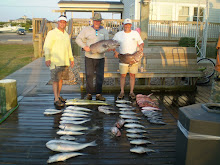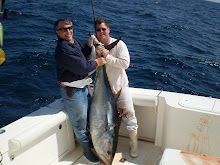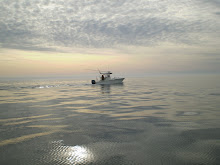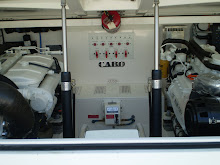
By Jim Field
Returning to Alexandria from our Hatteras fishing trip on Saturday, we stopped by to climb the Cape Hatteras lighthouse. In the gift shop I purchased a National Park Service guidebook to the historic U.S. Weather Bureau Station in Hatteras village, which was beautifully restored a decade ago and now serves as the town's visitor information center. The building is located right downtown, with the Red and White grocery on its left and Captain DM's family home on its right.
The building was erected in 1902 to replace an original structure--a small one-story framed structure. The Federal Government purchased the land for $110.35 and the cost to erect the new station was $5,194.
In 1870, President Ulysses S. Grant established a national weather service, to be headquartered in Washington DC. The plan was to establish weather observation sites across the country that would send weather data to HQ by telegraph three times each day, which HQ staff would use to compile a national weather map and local forecasts. The first coastal observation station in North Carolina was placed in Wilmington in 1871. Hatteras Village was assigned the next NC station in 1874. The data collected consisted of the following:
- Temperature and its 24 hour change
- Relative humidity
- Wind velocity
- Pressure of the wind (pounds per square foot)
- Barometric pressure
- Amount of clouds
- State of the weather
The weather observers lived in the station with his family--a situation akin to that of lighthouse keepers. The Hatteras observer S.L. Dosher (more from him later) wrote of his existence:
"The lonely life one is forced to lead...here and the...continuous round of duty one must perform in keeping up the work alone, where there are none of the diverting pleasures of civilization to break the dull, soporific monotony of the situation, prove after a time to be a strain that depresses even the most optimistic nature, and a physical and an intellectual menace that even the most robust constitution and the strongest mentality can not long withstand."
 In reading through the guidebook this morning in bed (Father's Day), I came across a letter that Weather Observer Dosher had written to headquarters about a hurricane that just passed through Hatteras Village a few days earlier. No more than a few paragraphs in, the reader quickly recognizes that this eye-witness account is a remarkable document--no other way to describe it--and I decided that I simply had to post an entry about it. What Dosher describes to his boss is really hard to imagine--the utter devastation that occurred to Hatteras Village and its inhabitants, and his personal travails in dealing with it as both a government official and local himself.
In reading through the guidebook this morning in bed (Father's Day), I came across a letter that Weather Observer Dosher had written to headquarters about a hurricane that just passed through Hatteras Village a few days earlier. No more than a few paragraphs in, the reader quickly recognizes that this eye-witness account is a remarkable document--no other way to describe it--and I decided that I simply had to post an entry about it. What Dosher describes to his boss is really hard to imagine--the utter devastation that occurred to Hatteras Village and its inhabitants, and his personal travails in dealing with it as both a government official and local himself. Before re-creating Dosher's letter, however, I decided to do some background research to see if I could find some details about the hurricane in question. Turns out, using the simple keyword "Hurricane 1899," it popped right up on Wikipedia. The hurricane was named "San Ciriaco," and it was a real killer that still holds some records today. From Wikipedia:
1899 Hurricane San Ciriaco, also known as the 1899 Puerto Rico Hurricane, was the longest-lived Atlantic hurricane and the eleventh deadliest tropical cyclone in the [Carribean] basin. It was an intense and long-lived Atlantic Cape Verde-type hurricane which crossed Puerto Rico over the two day period August 8 to August 9, 1899. Many deaths occurred as a result, due to flooding. The cyclone kept tropical storm strength or higher for 28 days, which makes it the longest duration Atlantic hurricane on record and the second-longest anywhere in the world (behind Hurricane John in 1994).
After it passed Puerto Rico, it brushed northern Dominican Republic as a Category 3 hurricane, but passed north enough to not cause major damage. It passed through the Bahamas, retaining its strength as it moved slowly northward. After drifting northeastward, the hurricane turned northwestward, hitting the Outer Banks on August 17. It drifted northeastward over the state, re-emerging into the Atlantic on the 19th.
Estimates of storm-related fatalities range from 3,100 to 3,400, with millions of dollars in crop damage in Puerto Rico. North Carolina had considerable tobacco and corn damage from the longevity of the strong winds and rain.
Also, with an Accumulated cyclone energy of 73.57, it has the highest ACE of any Atlantic hurricane in history. In 2004, Hurricane Ivan became the second Atlantic hurricane to surpass an ACE value of 70, but did not surpass the San Ciriaco hurricane.
Interestingly, Wikipedia also provided a graphic representation of the hurricane's track, which is shown below. Sadly for those in Hatteras, the storm seemed to go out of its way, pausing and making a special westerly detour to ensure it flattened the island and village.

Here, now, is the full letter sent by Weather Observer Dosher to his Chief in Washington, DC, two days after the storm departed.
Note: although a bit long, it's definitely worth a read; it starts out slow and then becomes riveting and unimaginable. From our vantage point of 2010, it's hard to put oneself into the scenario described. But try to imagine what fell on these people, and what it would feel like--the sights and sounds--if James Cameron made it into a 3D IMAX movie! People would be traumatized.
Hatteras Devastated by Hurricane
U.S. Department of Agriculture
Weather Bureau
Office of the Observer
Subject: Hurricane
Station: Hatteras, North Carolina
Date: August 21, 1899
Chief of the Weather Bureau,
Washington, DC
Sir:
I have the honor to make the following report of the severe hurricane which swept over this section on the 16th, 17th, and 18th instantly.
The wind began blowing a gale from the east on the morning of the 16th, varying in velocity from 35 to 50 miles an hour...During the early morning of the 17th the wind increased to a hurricane and at about 4 a.m. it was blowing at a rate of 70 miles, at 10 a.m. it had increased to 84 miles and at 1 p.m. is was blowing at a velocity of 93 miles with occasional extreme velocities of 120 miles to 140 per hour. The record of wind from about 1 p.m. was lost, but it is estimated that the wind blew even with greater force from about 3 p.m. to 7 p.m. and it is believed that between these hours the wind reached a regular velocity of at least 100 miles per hour...
At about 7:30 p.m. on the 17th there was a very decided lull in the force of the wind and at 8.m. it had fallen out until only a gentle breeze was blowing. This lull did not last more than a half hour, however, before the wind veered to the east and then switched south-east and began blowing at a velocity estimated from 60 to 70 miles per hour which continued until well into the morning of the 18th. During the morning of the 18th the wind veered to the south and continued to blow a gale, with heavy rain squalls, all day, decreasing somewhat in the late evening and going into southwest. This day may be said to be the end of the hurricane, although the weather continued squally on the 19th, but without any winds of very high velocity.
This hurricane was, without question, the most severe storm that has ever passed over this section within the memory of any person now living, and there are people here who can remember back for a period of over 75 years. I have made careful inquiry among the old inhabitants here, and they all agree, with one accord, that no storm like this has ever visited the island...
The scene here on the 17th was wild and terrifying in the extreme. By 8 a.m. on that date the entire island was covered with water blown in from the sound, and by 1 a.m. all the land was covered to a depth of from 3 to ten feet. The tide swept over the island at a fearful rate carrying everything movable before it. There were not more than four houses on the island in which the tide did not rise to a depth from one t four feet, and at least half of the people had to abandon their homes and property to the mercy of the wind and tide and seek the safety of their own lives with those who were fortunate enough to live on higher land.
Language is inadequate to express the conditions which prevailed all day on the 17th. The howling wind, the rushing and roaring tide and the awful sea which swept over the beach and thundered like a thousand pieces of artillery made a picture which was at once appalling and terrible and the like of which Dante's Inferno could scarcely equal.
The frightened people were grouped sometimes 40 or 50 in one house, and at times one house would have to be abandoned and they would all have to wade almost beyond their depth in order to reach another. All day this gale, tide, and sea continued with a fury and persistent energy that knew no abatement, and the strain on the minds of every one was something so frightful and dejecting that it cannot be expressed.
In many houses families were huddled together in the upper portion of the building with the water several feet deep in the lower portion, not knowing what minute the house would either be blown down or swept away by the tide...
Cattle, sheep, hogs and chickens were drowned by the hundreds before the very eyes of the owners, who were powerless to render any assistance on account of the rushing tide. The fright of these poor animals was terrible to see, and their cries of horror when being surrounded by the water were pitiful in the extreme.
The damage done to this place by the hurricane is, at this time difficult to estimate...but is believed that the total loss to Hatteras alone will amount to from $15,0000 to $20,000. The fishing business here is the principal industry from which is derived the revenue upon which the great majority live, and it may be said that this industry has for the present time been swept away entirely out of existence...
A great majority of the houses on the island were badly damaged, and 5 or 6 are so badly wrecked as to be unfit for habitation and that many families are without homes, living wherever they can best find a home. The Southern Methodist church building was completely wrecked...All the bridges and footways over the creeks and small streams were swept away...The roadways are piled from three to ten feet high with wreckage...
The telegraph and telephone lines are both down...It is reported that several vessels are stranded north of [Big Kinnakeet Life Saving Station]...
A large steamship foundered about a mile off Hatteras beach..and is thought all onboard were drowned...
The Diamond Shoals Light Ship which was stationed off Hatteras, broke loose from her mooring on the morning of the 17th and was carried southward by the gale...This vessel will probably prove a total loss...
(Photograph of beached Light Ship 69)

The damage to the instruments and property of the Bureau here was considerable...The office building was flooded with water to the depth of about 18 inches, and the rain beat in at the roof and windows until the entire building was a mass of water...
I live about a mile from the office building and when I went home at 8 a.m. I had to wade in water which was about waist deep. I waited until about 10:30 a.m., thinking the storm would lull, but it did not do so, and at this time I started for the office...I got about one-third of the distance and found the water about breast height, when I had to stop in a neighbor's house and rest, the strain of pushing through the water and storm having nearly exhausted my strength. I rested there until about noon when I started again and after going a short distance further I found the water up to my shoulders...I had to give it up again and take refuge in another neighbor's house where I had to remain until about 8 p.m. when the tide fell so that I could reach the office...
I started to the office against the advise of those who were better acquainted with the condition of the roads than I, and continued on my way until I saw that the attempt was rash and fool-hardy and that I was certain to reach low places where I would be swept off my feet and drowned...There has never been any such tide as the one mentioned here.
...The rainfall...was as heavy as I have ever seen. It fell in a perfect torrent and at times was so thick and in such blinding sheets that it was impossible to see across a roadway 20 feet wide.
...Everything went before the fury of the gale. No lives were lost at Hatteras, although many narrow escapes occurred, several families being washed from their homes in the tide and storm. At Ocracoke and Portsmouth, 16 and 20 miles south of this station the storm is reported about the same as Hatteras, with a corresponding damage to property. Reliable details from these places however, being lacking. A pleasure boat at Ocracoke with a party of men from Washington, DC, was lost and a portion of the party were drowned.
There has been no communication with this place by wire or mail since the storm, and it is not known when there will be. It is therefore requested that so much of this report as may be of interest to the public be given to the Associated Press for publication in the newspaper.
Very respectfully,
S.L. Dosher
Observer, Weather Bureau
And there you have it, all in a day's work for faithful Dosher.









No comments:
Post a Comment